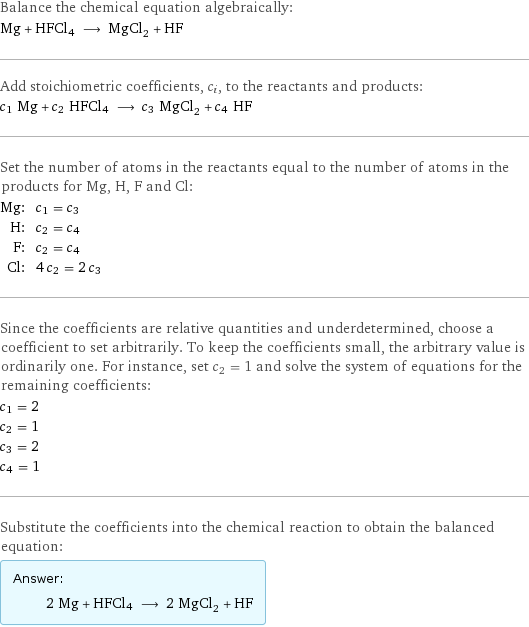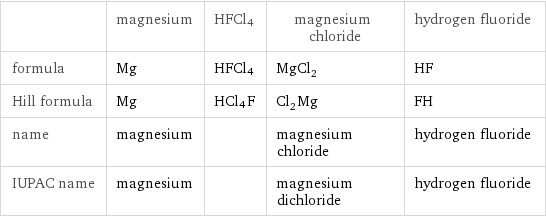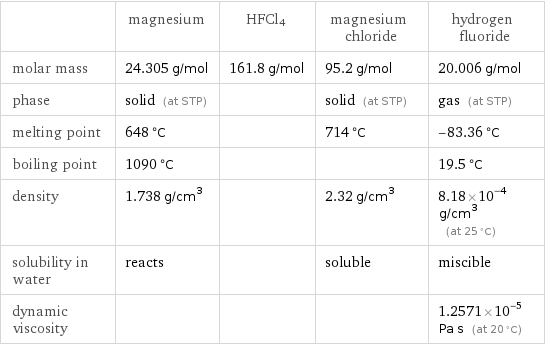Input interpretation

Mg magnesium + HFCl4 ⟶ MgCl_2 magnesium chloride + HF hydrogen fluoride
Balanced equation

Balance the chemical equation algebraically: Mg + HFCl4 ⟶ MgCl_2 + HF Add stoichiometric coefficients, c_i, to the reactants and products: c_1 Mg + c_2 HFCl4 ⟶ c_3 MgCl_2 + c_4 HF Set the number of atoms in the reactants equal to the number of atoms in the products for Mg, H, F and Cl: Mg: | c_1 = c_3 H: | c_2 = c_4 F: | c_2 = c_4 Cl: | 4 c_2 = 2 c_3 Since the coefficients are relative quantities and underdetermined, choose a coefficient to set arbitrarily. To keep the coefficients small, the arbitrary value is ordinarily one. For instance, set c_2 = 1 and solve the system of equations for the remaining coefficients: c_1 = 2 c_2 = 1 c_3 = 2 c_4 = 1 Substitute the coefficients into the chemical reaction to obtain the balanced equation: Answer: | | 2 Mg + HFCl4 ⟶ 2 MgCl_2 + HF
Structures

+ HFCl4 ⟶ +
Names

magnesium + HFCl4 ⟶ magnesium chloride + hydrogen fluoride
Equilibrium constant
![Construct the equilibrium constant, K, expression for: Mg + HFCl4 ⟶ MgCl_2 + HF Plan: • Balance the chemical equation. • Determine the stoichiometric numbers. • Assemble the activity expression for each chemical species. • Use the activity expressions to build the equilibrium constant expression. Write the balanced chemical equation: 2 Mg + HFCl4 ⟶ 2 MgCl_2 + HF Assign stoichiometric numbers, ν_i, using the stoichiometric coefficients, c_i, from the balanced chemical equation in the following manner: ν_i = -c_i for reactants and ν_i = c_i for products: chemical species | c_i | ν_i Mg | 2 | -2 HFCl4 | 1 | -1 MgCl_2 | 2 | 2 HF | 1 | 1 Assemble the activity expressions accounting for the state of matter and ν_i: chemical species | c_i | ν_i | activity expression Mg | 2 | -2 | ([Mg])^(-2) HFCl4 | 1 | -1 | ([HFCl4])^(-1) MgCl_2 | 2 | 2 | ([MgCl2])^2 HF | 1 | 1 | [HF] The equilibrium constant symbol in the concentration basis is: K_c Mulitply the activity expressions to arrive at the K_c expression: Answer: | | K_c = ([Mg])^(-2) ([HFCl4])^(-1) ([MgCl2])^2 [HF] = (([MgCl2])^2 [HF])/(([Mg])^2 [HFCl4])](../image_source/ac5a3b03c0410f407890c8117df8f6fb.png)
Construct the equilibrium constant, K, expression for: Mg + HFCl4 ⟶ MgCl_2 + HF Plan: • Balance the chemical equation. • Determine the stoichiometric numbers. • Assemble the activity expression for each chemical species. • Use the activity expressions to build the equilibrium constant expression. Write the balanced chemical equation: 2 Mg + HFCl4 ⟶ 2 MgCl_2 + HF Assign stoichiometric numbers, ν_i, using the stoichiometric coefficients, c_i, from the balanced chemical equation in the following manner: ν_i = -c_i for reactants and ν_i = c_i for products: chemical species | c_i | ν_i Mg | 2 | -2 HFCl4 | 1 | -1 MgCl_2 | 2 | 2 HF | 1 | 1 Assemble the activity expressions accounting for the state of matter and ν_i: chemical species | c_i | ν_i | activity expression Mg | 2 | -2 | ([Mg])^(-2) HFCl4 | 1 | -1 | ([HFCl4])^(-1) MgCl_2 | 2 | 2 | ([MgCl2])^2 HF | 1 | 1 | [HF] The equilibrium constant symbol in the concentration basis is: K_c Mulitply the activity expressions to arrive at the K_c expression: Answer: | | K_c = ([Mg])^(-2) ([HFCl4])^(-1) ([MgCl2])^2 [HF] = (([MgCl2])^2 [HF])/(([Mg])^2 [HFCl4])
Rate of reaction
![Construct the rate of reaction expression for: Mg + HFCl4 ⟶ MgCl_2 + HF Plan: • Balance the chemical equation. • Determine the stoichiometric numbers. • Assemble the rate term for each chemical species. • Write the rate of reaction expression. Write the balanced chemical equation: 2 Mg + HFCl4 ⟶ 2 MgCl_2 + HF Assign stoichiometric numbers, ν_i, using the stoichiometric coefficients, c_i, from the balanced chemical equation in the following manner: ν_i = -c_i for reactants and ν_i = c_i for products: chemical species | c_i | ν_i Mg | 2 | -2 HFCl4 | 1 | -1 MgCl_2 | 2 | 2 HF | 1 | 1 The rate term for each chemical species, B_i, is 1/ν_i(Δ[B_i])/(Δt) where [B_i] is the amount concentration and t is time: chemical species | c_i | ν_i | rate term Mg | 2 | -2 | -1/2 (Δ[Mg])/(Δt) HFCl4 | 1 | -1 | -(Δ[HFCl4])/(Δt) MgCl_2 | 2 | 2 | 1/2 (Δ[MgCl2])/(Δt) HF | 1 | 1 | (Δ[HF])/(Δt) (for infinitesimal rate of change, replace Δ with d) Set the rate terms equal to each other to arrive at the rate expression: Answer: | | rate = -1/2 (Δ[Mg])/(Δt) = -(Δ[HFCl4])/(Δt) = 1/2 (Δ[MgCl2])/(Δt) = (Δ[HF])/(Δt) (assuming constant volume and no accumulation of intermediates or side products)](../image_source/9b8acaf4d32456876f5359185b8bff97.png)
Construct the rate of reaction expression for: Mg + HFCl4 ⟶ MgCl_2 + HF Plan: • Balance the chemical equation. • Determine the stoichiometric numbers. • Assemble the rate term for each chemical species. • Write the rate of reaction expression. Write the balanced chemical equation: 2 Mg + HFCl4 ⟶ 2 MgCl_2 + HF Assign stoichiometric numbers, ν_i, using the stoichiometric coefficients, c_i, from the balanced chemical equation in the following manner: ν_i = -c_i for reactants and ν_i = c_i for products: chemical species | c_i | ν_i Mg | 2 | -2 HFCl4 | 1 | -1 MgCl_2 | 2 | 2 HF | 1 | 1 The rate term for each chemical species, B_i, is 1/ν_i(Δ[B_i])/(Δt) where [B_i] is the amount concentration and t is time: chemical species | c_i | ν_i | rate term Mg | 2 | -2 | -1/2 (Δ[Mg])/(Δt) HFCl4 | 1 | -1 | -(Δ[HFCl4])/(Δt) MgCl_2 | 2 | 2 | 1/2 (Δ[MgCl2])/(Δt) HF | 1 | 1 | (Δ[HF])/(Δt) (for infinitesimal rate of change, replace Δ with d) Set the rate terms equal to each other to arrive at the rate expression: Answer: | | rate = -1/2 (Δ[Mg])/(Δt) = -(Δ[HFCl4])/(Δt) = 1/2 (Δ[MgCl2])/(Δt) = (Δ[HF])/(Δt) (assuming constant volume and no accumulation of intermediates or side products)
Chemical names and formulas

| magnesium | HFCl4 | magnesium chloride | hydrogen fluoride formula | Mg | HFCl4 | MgCl_2 | HF Hill formula | Mg | HCl4F | Cl_2Mg | FH name | magnesium | | magnesium chloride | hydrogen fluoride IUPAC name | magnesium | | magnesium dichloride | hydrogen fluoride
Substance properties

| magnesium | HFCl4 | magnesium chloride | hydrogen fluoride molar mass | 24.305 g/mol | 161.8 g/mol | 95.2 g/mol | 20.006 g/mol phase | solid (at STP) | | solid (at STP) | gas (at STP) melting point | 648 °C | | 714 °C | -83.36 °C boiling point | 1090 °C | | | 19.5 °C density | 1.738 g/cm^3 | | 2.32 g/cm^3 | 8.18×10^-4 g/cm^3 (at 25 °C) solubility in water | reacts | | soluble | miscible dynamic viscosity | | | | 1.2571×10^-5 Pa s (at 20 °C)
Units
